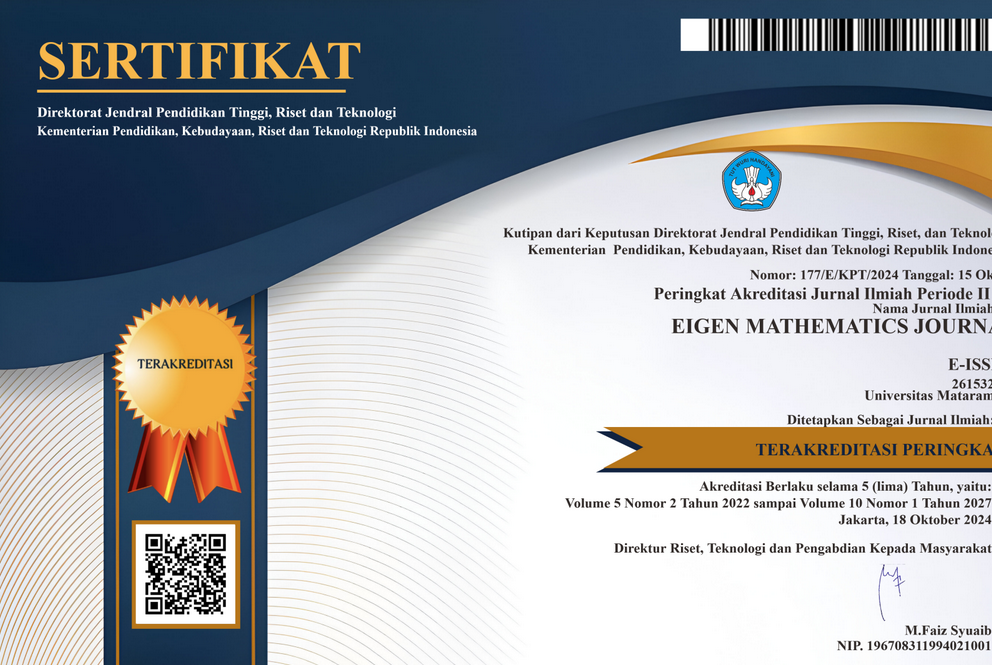Comparison of Several Univariate Time Series Methods for Inflation Rate Forecasting
DOI:
https://doi.org/10.29303/emj.v7i2.200Keywords:
ARIMA, Double Exponential Smoothing, RMSE, Trend ProjectionAbstract
Forecasting inflation is very crucial for a country because inflation is one of indicator to measure development of the country. This study aims to evaluate the effectiveness of three univariate time series methods i.e., ARIMA (Autoregressive Integrated Moving Average), Double Exponential Smoothing (DES), and Trend Projection (TP), in forecasting Indonesia’s monthly inflation rates using data from 2018 to 2022. The analysis identifies DES as the most accurate method, evidenced by its lowest Root Mean Square Error (RMSE) value of 2.9296, outperforming ARIMA and TP, which have RMSE values of 13.1479 and 3.47053, respectively. Consequently, DES was selected as the preferred model for forecasting inflation over the next 36 month, with the forecasts indicating a consistent downward trend in inflation throughout the year. While these findings highlight DES's effectiveness, the study also acknowledges limitations, including its reliance on univariate models that do not incorporate other economic variables, and the potential limitations of the dataset’s specific time frame. To address these limitations, future research should consider multivariate models, integrate machine learning techniques, and conduct scenario analyses to improve forecast accuracy and robustness. Despite these constraints, the study provides valuable insights into inflation forecasting in Indonesia, offering a practical tool for policymakers and contributing to more informed economic decision-making.References
Hayuningtyas, R. Y. “Sistem Informasi Peramalan Persediaan Barang Menggunakan Metode SES Dan DES,” Indones. J. Softw. Eng., vol. 4, no. 1, pp. 1–6, 2019, doi: https://doi.org/10.31294/ijse.v4i1.6228
Hyndman, R. J., dan Athanasopoulos, G. Forecasting: principles and practice, 2nd ed. Melbourne, Australia.: OTexts, 2018. [Online]. Available: https://otexts.com/fpp2
Hyndman, R. J., Koehler, A. B., Ord, J. K., dan Snyder, R. D. Forecasting with Exponential Smoothing: The State Space Approach. Berlin, Germany: Springer Berlin Heidelberg, 2008. https://robjhyndman.com/expsmooth/
Irawan, R. Y., Yuly Saptomo, W. L., dan Setiyowati, S. “Penerapan Metode Double Exponential Smoothing Untuk Peramalan Tingkat Indeks Pembangunan Manusia Berbasis Sistem Informasi Goegrafis Di Provinsi Jawa Tengah,” J. Teknol. Inf. dan Komun., vol. 7, no. 2, pp. 18–28, 2019, doi: https://doi.org/10.30646/tikomsin.v7i2.437
Lembang, F. K. “Prediksi Laju Inflasi Di Kota Ambon Menggunakan Metode ARIMA Box Jenkins,” Stat. J. Theor. Stat. Its Appl., vol. 16, no. 2, pp. 95–102, 2017, doi: https://doi.org/10.29313/jstat.v16i2.2188
Madu, A., “Perbandingan Metode Trend Projection Dan Metode Backpropagation Dalam Meramalkan Jumlah Korban Kecelakaan Lalu Lintas Yang Meninggal Dunia Di Kabupaten Timor Tengah Utara, Nusa Tenggara Timur,” J. Mercumatika, vol. 1, no. 1, pp. 44–57, 2016. doi: https://doi.org/10.26486/mercumatika.v1i1.188
Mizan, S. Suriani, B. D. P. R, N., Mihaimin, R., Laili, N. dan Ernita, W. “Peramalan Data Penduduk Miskin Provinsi Nusa Tenggara Barat ( NTB ) Model Auto Regressive Integrated Moving Average ( ARIMA ),” J. Pemikir. dan Penelit. Pendidik. Mat., vol. 2, no. 1, pp. 1–10, 2019. https://journal.rekarta.co.id/index.php/jp3m/article/view/207
Sarbaini, S., & Nazaruddin, N. (2023). Pengaruh kenaikan BBM terhadap laju inflasi di Indonesia. Jurnal Teknologi Dan Manajemen Industri Terapan, 2(I), 25-32. doi: https://doi.org/10.55826/tmit.v2iI.132
Silfiani, M. “Forecasting Inflation in Indonesia Using Hybrid ARIMA and Artificial Neural Networks Ensemble,” Asian Institute of Technology, 2014. https://repository.its.ac.id/105400/
Silfiani M. dan Lembang, G. R. “Perbandingan Peramalan Jumlah Kasus Kecelakaan Lalu Lintas Kota Balikpapan dengan Linear Trend Analysis dan Double Exponential Smoothing,” vol. 01, pp. 14–18, 2023. doi: https://doi.org/10.35718/equiva.v1i1.757
Silfiani, M. dan Suhartono, “Aplikasi Metode Ensembel untuk Peramalan Inflasi di Indonesia,” J. Sains dan Seni ITS, vol. 1, no. 1, pp. D171–D176, 2012. doi: http://dx.doi.org/10.12962/j23373520.v1i1.1965
Wardani, R. P. dan Winarno, B. “Model Peramalan Laju Inflasi di Jawa Tengah Menggunakan Metode Hybrid ARIMA (Autoregressive Integrated Moving Average)-ANFIS (Adaptive Neuro Fuzzy Inference System),” Pros. Semin. Nas. Mat., vol. 6, pp. 739–744, 2023, https://journal.unnes.ac.id/sju/prisma/article/view/66920
Wei, W. W. S.Time Series Analysis - Univariate and Multivariate Methods, Second edi. Boston: Pearson Addison Wesley, 2006.
Downloads
Published
How to Cite
Issue
Section
License

This work is licensed under a Creative Commons Attribution-NonCommercial-ShareAlike 4.0 International License.
All articles published in the Eigen Mathematics Journal will be available for free reading and downloading. The license applied to this journal is Creative Commons Attribution-Non-Commercial-Share Alike (CC BY-NC-SA).
Similar Articles
- Nuzla Af’idatur Robbaniyyah, Salwa Salwa, Andika Ellena Saufika Hakim Maharani, Numerical Analysis of Mathematical Model for Diabetes Mellitus Disease by Using Adam-Bashfort Moulton Method , EIGEN MATHEMATICS JOURNAL: Vol. 7 No. 2 (2024): December
You may also start an advanced similarity search for this article.
Most read articles by the same author(s)
- Mega Silfiani, Farida Nur Hayati, Surya Puspita Sari, Agung Prabowo, COVID-19 Intervention Model for Bali Province GRDP Prediction , EIGEN MATHEMATICS JOURNAL: Vol. 5 No. 2 Desember 2022






